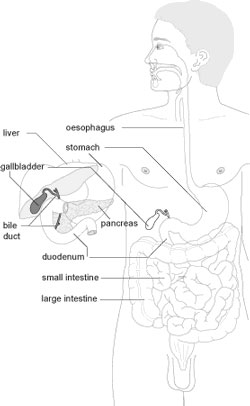
The gallbladder is a small pear-shaped pouch situated under the liver in the upper right part of the abdomen. It stores bile, a liquid produced by the liver, and then releases it into the intestine to help digestion.
The gallbladder may need to be removed to treat gallstones. The operation is usually done using keyhole surgery, which is called laparoscopic cholecystectomy (co-lee-sist-ek-tomy).

Gallstones are small, hard stones, which can sometimes develop in the gallbladder. They can result in a blockage of the flow of bile out of the gallbladder and symptoms that can include pain, jaundice (yellowed skin), and fever.
The body can function well without a gallbladder and removing it is a common treatment for gallstones that are causing symptoms.
Most gallbladder surgery is performed laparoscopically ("keyhole surgery"), but a small number of people need open surgery.
A laparoscopic cholecystectomy usually lasts 60-90 minutes and requires a stay in hospital of two nights. The operation is performed under a general anaesthetic, which means that the person is asleep and feels no pain. Typically, people are asked not to eat or drink for six hours before a general anaesthetic. Some anaesthetists allow a few sips of water until two hours before.
Once the anaesthetic has taken effect, a hollow needle is inserted through or near the umbilicus (belly button) and used to inflate the abdomen slightly with carbon dioxide gas. The laparoscope (a long, thin telescope) is then inserted through another small incision. This gives the surgeon a view of the internal organs on a video monitor.
To remove the gallbladder, specially adapted surgical instruments are inserted through two further small incisions. The incisions used in this type of surgery are usually between one and two centimetres long. When the operation is complete, the incisions are closed with stitches and the four small wounds are covered with dressings.
Laparoscopic cholecystectomy is the most commonly performed type of abdominal surgery and is generally a safe operation. For most people, the benefits in terms of improved symptoms are far greater than the disadvantages.
However, in order to give informed consent, anyone deciding whether or not to have this procedure needs to be aware of the possible side-effects and the risk of complications.
Side-effects are the unwanted but mostly mild and temporary effects of a successful procedure. Examples of side-effects include feeling sick as a result of the general anaesthetic or painkillers. Medicines are available to help avoid this. In addition, common side-effects of laparoscopic cholecystectomy include:
Complications are unexpected problems that can occur during or after the procedure. Most people are not affected. However, possible complications of any operation are:
Further treatment, such as another operation to stop any bleeding or antibiotics to deal with an infection, may be needed.
The possible complications specific to a laparoscopic cholecystectomy are:
Occasionally, it is not possible to complete the operation with the "keyhole" method and the operation may need to be converted to opening the abdomen. This complication is uncommon.
In the longer term, some people experience ongoing abdominal symptoms, such as pain, bloating, wind and diarrhea. This is known as "postcholecystectomy syndrome" and may require further investigation and treatment.
Enter your details below & we will call you back